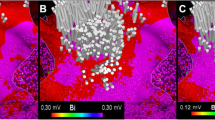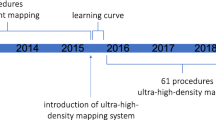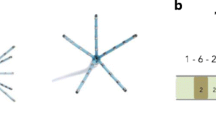Abstract
Purpose
We aimed to assess the feasibility, safety, and operator feedback of a novel star-shaped high-density mapping catheter containing 48 platinum-iridium mapping electrodes distributed across eight spines.
Methods
This prospective, single-arm, first-in-human study was conducted at five European sites. Primary endpoints were completion of pre-ablation mapping requirements, obtaining clinically indicated mapping with the new catheter without resorting to non-study mapping catheters, and incidence of serious adverse events (SAEs). Physician feedback survey assessed catheter performance, including deployment, ease of use, and mapping results. The subjects were followed for 7 days post-procedure.
Results
Of 31 patients enrolled (11 ventricular tachycardia [VT], 10 scar-related atrial tachycardia [AT]/atypical atrial flutter [AFL], and 10 persistent atrial fibrillation [PsAF]), 28 had study catheter inserted for mapping purposes. Pre-ablation mapping was achieved in 23/28 patients (82.1%). Median of total pre-ablation mapping times were 121.0, 72.5, and 31.5 min for the VT, scar-related AT/atypical AFL, and PsAF subgroups, respectively. More than two-thirds of mapping points acquired were used to generate CARTO maps relevant for ablation. All 16 patients who had conduction channel(s), gaps(s), or critical isthmus identified had the areas successfully mapped. The ability to deploy, maneuver, and reach the atria and ventricles using the catheter was rated positively for most procedures. Only one SAE (heart failure) was reported, unrelated to the device.
Conclusion
The study results demonstrate the feasibility of the OCTARAY catheter to successfully map complex arrhythmias with good safety profile. Operator feedback indicates satisfaction with ease of use and maneuverability of the catheter.





Similar content being viewed by others
Data availability
Johnson & Johnson Medical Devices Companies have an agreement with the Yale Open Data Access (YODA) Project to serve as the independent review panel for the evaluation of requests for clinical study reports and patient-level data from investigators and physicians for scientific research that will advance medical knowledge and public health. Requests for access to the study data can be submitted through the YODA Project site at http://yoda.yale.edu.
Code availability
Not applicable.
References
Calkins H, Hindricks G, Cappato R, Kim YH, Saad EB, Aguinaga L, et al. 2017 HRS/EHRA/ECAS/APHRS/SOLAECE expert consensus statement on catheter and surgical ablation of atrial fibrillation. Europace. 2018;20(1):e1–160. https://doi.org/10.1093/europace/eux274.
Cronin EM, Bogun FM, Maury P, Peichl P, Chen M, Namboodiri N, et al. 2019 HRS/EHRA/APHRS/LAHRS expert consensus statement on catheter ablation of ventricular arrhythmias. Heart Rhythm. 2020;17(1):e2–154. https://doi.org/10.1016/j.hrthm.2019.03.002.
Kim YH, Chen SA, Ernst S, Guzman CE, Han S, Kalarus Z, et al. 2019 APHRS expert consensus statement on three-dimensional mapping systems for tachycardia developed in collaboration with HRS, EHRA, and LAHRS. J Arrhythm. 2020;36(2):215–70. https://doi.org/10.1002/joa3.12308.
Latcu DG, Bun SS, Casado Arroyo R, Wedn AM, Benaich FA, Hasni K et al. Scar identification, quantification, and characterization in complex atrial tachycardia: a path to targeted ablation? Europace. 2019;21(Supplement_1):i21-i6. https://doi.org/10.1093/europace/euy182.
Pashakhanloo F, Herzka DA, Halperin H, McVeigh ER, Trayanova NA. Role of 3-dimensional architecture of scar and surviving tissue in ventricular tachycardia: insights from high-resolution ex vivo porcine models. Circ Arrhythm Electrophysiol. 2018;11(6): e006131. https://doi.org/10.1161/CIRCEP.117.006131.
Verma A, Wazni OM, Marrouche NF, Martin DO, Kilicaslan F, Minor S, et al. Pre-existent left atrial scarring in patients undergoing pulmonary vein antrum isolation: an independent predictor of procedural failure. J Am Coll Cardiol. 2005;45(2):285–92. https://doi.org/10.1016/j.jacc.2004.10.035.
Sroubek J, Rottmann M, Barkagan M, Leshem E, Shapira-Daniels A, Brem E, et al. A novel octaray multielectrode catheter for high-resolution atrial mapping: electrogram characterization and utility for mapping ablation gaps. J Cardiovasc Electrophysiol. 2019;30(5):749–57. https://doi.org/10.1111/jce.13867.
Barkagan M, Sroubek J, Shapira-Daniels A, Yavin H, Jang J, Nezafat R, et al. A novel multielectrode catheter for high-density ventricular mapping: electrogram characterization and utility for scar mapping. Europace. 2020;22(3):440–9. https://doi.org/10.1093/europace/euz364.
Campbell T, Trivic I, Bennett RG, Anderson RD, Turnbull S, Pham T, et al. Catheter ablation of ventricular arrhythmia guided by a high-density grid catheter. J Cardiovasc Electrophysiol. 2020;31(2):474–84. https://doi.org/10.1111/jce.14351.
Jiang R, Beaser AD, Aziz Z, Upadhyay GA, Nayak HM, Tung R. High-density grid catheter for detailed mapping of sinus rhythm and scar-related ventricular tachycardia: comparison with a linear duodecapolar catheter. JACC Clin Electrophysiol. 2020;6(3):311–23. https://doi.org/10.1016/j.jacep.2019.11.007.
Garcia-Bolao I, Ballesteros G, Ramos P, Menendez D, Erkiaga A, Neglia R et al. Identification of pulmonary vein reconnection gaps with high-density mapping in redo atrial fibrillation ablation procedures. Europace. 2018;20(FI_3):f351-f8. https://doi.org/10.1093/europace/eux184.
Mantziari L, Butcher C, Kontogeorgis A, Panikker S, Roy K, Markides V, et al. Utility of a novel rapid high-resolution mapping system in the catheter ablation of arrhythmias: an initial human experience of mapping the atria and the left ventricle. JACC Clin Electrophysiol. 2015;1(5):411–20. https://doi.org/10.1016/j.jacep.2015.06.002.
Jungen C, Akbulak R, Kahle AK, Eickholt C, Schaeffer B, Scherschel K, et al. Outcome after tailored catheter ablation of atrial tachycardia using ultra-high-density mapping. J Cardiovasc Electrophysiol. 2020;31(10):2645–52. https://doi.org/10.1111/jce.14703.
Viswanathan K, Mantziari L, Butcher C, Hodkinson E, Lim E, Khan H, et al. Evaluation of a novel high-resolution mapping system for catheter ablation of ventricular arrhythmias. Heart Rhythm. 2017;14(2):176–83. https://doi.org/10.1016/j.hrthm.2016.11.018.
Pott A, Petscher K, Baumhardt M, Stephan T, Rattka M, Paliskyte R, et al. Novel spiral mapping catheter facilitates observation of the time-to-pulmonary vein isolation during cryoballoon ablation. Heart Vessels. 2019;34(3):496–502. https://doi.org/10.1007/s00380-018-1254-x.
Daoud EG, Zeidan Z, Hummel JD, Weiss R, Houmsse M, Augostini R, et al. Identification of repetitive activation patterns using novel computational analysis of multielectrode recordings during atrial fibrillation and flutter in humans. JACC Clin Electrophysiol. 2017;3(3):207–16. https://doi.org/10.1016/j.jacep.2016.08.001.
Baykaner T, Zaman JAB. Another method that shows organization in persistent AF? That’s a RAAP J Cardiovasc Electrophysiol. 2019;30(12):2713–5. https://doi.org/10.1111/jce.14215.
Acknowledgements
The authors wish to express their appreciation to all the OCTARAY first-in-human trial investigators. In addition, the authors wish to thank the following individuals for their efforts in the execution of the trial and statistical analysis, and for providing valuable input into the development of the study design and manuscript: Nathalie Macours, Qun Sha, Wannes Vermander, Lee Ming Boo, Christina Kaneko, and Renata Hansen. Additional writing support was provided by Michelle Hughes, PhD (Cello Health Communications/MedErgy), which was funded by Biosense Webster, Inc.
Funding
This study was funded by Biosense Webster, Inc.
Author information
Authors and Affiliations
Contributions
All authors contributed to the study conception and design. Data collection and analysis were performed by all authors. All authors contributed to the first draft of the manuscript, commented on subsequent versions of the manuscript, and read and approved the final manuscript for submission.
Corresponding author
Ethics declarations
Ethics approval
The study was conducted in accordance with the Declaration of Helsinki with E6 of the International Conference of Harmonization Good Clinical Practices, ISO 14155–2011, and all applicable local and federal regulations, and was reviewed and approved by the ethics committees in all participating countries: Belgium (Ethisch comité UZA/UA, Ethische Toetsingscommissie van het Jessa Ziekenhuis and Ethisch comité van het OLV Ziekenhuis) and the UK (West of Scotland REC 4).
Consent to participate
All participants signed an informed consent form.
Consent for publication
Not applicable.
Conflict of interest
Dr. Andrea Sarkozy reports personal fees from Biosense Webster, outside of the submitted work. Dr. Richard Schilling is a founder and shareholder of Rhythm AI; has received personal fees and grants from Biosense Webster, Abbott, Medtronic, Boehringer Ingelheim, and Daiichi Sankyo; has received non-financial support from Apple; and has served as a consultant for Biosense Webster, outside of the submitted work. Dr. Vias Markides has served as a consultant and has received speaker honoraria from Biosense Webster, outside of the submitted work. Dr. Johan Vijgen and Dr. Tom De Potter declare that they have no conflicts of interest.
Additional information
Publisher's note
Springer Nature remains neutral with regard to jurisdictional claims in published maps and institutional affiliations.
Supplementary Information
Below is the link to the electronic supplementary material.
Rights and permissions
About this article
Cite this article
Sarkozy, A., Vijgen, J., De Potter, T. et al. An early multicenter experience of the novel high-density star-shaped mapping catheter in complex arrhythmias. J Interv Card Electrophysiol 64, 223–232 (2022). https://doi.org/10.1007/s10840-022-01176-2
Received:
Accepted:
Published:
Issue Date:
DOI: https://doi.org/10.1007/s10840-022-01176-2




